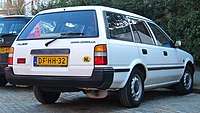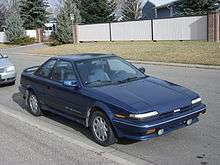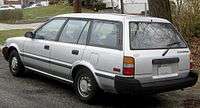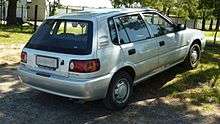Toyota Corolla (E90)
The Corolla E90, introduced in 1987 for the 1988 model year, was the sixth generation of cars sold by Toyota under the Corolla nameplate. It was the last generation of Corolla to be classified as a subcompact car and the first to be exclusively front-wheel drive or all-wheel drive;[3] the performance option of rear-wheel drive was dropped.
| Toyota Corolla (E90) | |
|---|---|
_CS_sedan_(2010-05-19).jpg) Pre-facelift Toyota Corolla CS sedan | |
| Overview | |
| Manufacturer | Toyota |
| Also called |
|
| Production |
|
| Assembly |
|
| Designer | Seiiji Fukushima (1984)[2] |
| Body and chassis | |
| Body style |
|
| Layout | Front engine, front-wheel drive / four-wheel drive |
| Powertrain | |
| Engine | |
| Transmission | |
| Dimensions | |
| Wheelbase | 2,431 mm (95.7 in) |
| Length |
|
| Width |
|
| Height |
|
| Curb weight | 1086 kg (2390 lb) |
| Chronology | |
| Predecessor |
|
| Successor | Corolla E100 |

For general export, the trim levels were Base, XL, GL, SE, and SE Limited. The GT-i (known as the SX Seca and/or Hatch in Australia) was a high-performance model powered by the 4A-GE engine; it was offered with hatchback and also five-door liftback bodywork in some markets. The North American GT-S coupé shared the same engine. The all-wheel drive Sprinter Carib wagon used a beam axle rear suspension with coil springs, while the rest used struts all around. In South Africa, the E90 was manufactured and marketed by Toyota under the Carri, Conquest, and Tazz model names. In a pair of similar joint ventures with General Motors, E90 variants with minor cosmetic changes were locally manufactured and sold as the Geo Prizm and Holden Nova in the United States and Australia respectively.
The majority of the Corolla range was replaced in June 1991 for the Japanese market, but production for export markets continued into 1992, and Australian Holden production extended until mid 1994. The all-wheel drive wagon was sold from 1988 to 1994 and had different bodywork to other Corollas; it replaced the Tercel 4WD Wagon/Sprinter Carib in Toyota's lineup. It actually continued to use the Sprinter Carib name in Japan, but was marketed as the Corolla Touring in Europe and some other countries, and as the Corolla All-Trac in the United States.
Japan
The 1.3 liter sedan has a four-speed manual transmission (later all 1.3 liter engines had five-speeds) or a three-speed automatic transmission. The only model with the 1.5 liter 5A-FHE was SE-Limited G. The 4WD sedan is powered by the 1.6 liter 4A-F. The 1456 cc 3E engine was only fitted to the Japanese market Van (wagon) commercial version.[4] The Sprinter sedan has a third window in the C-pillar and was unique to Toyota Vista Store Japanese dealerships.
The AE92 Levin and Trueno were also fitted with a supercharged engine. It used an SC12 roots type supercharger and a top mounted intercooler that was fed cool air via a scoop on the bonnet. They generated 206 N⋅m (152 lb⋅ft) at 4400 rpm as opposed to the naturally aspirated 4A-GE's 136 N⋅m (100 lb⋅ft) at 4,800 rpm.[4]
Japanese market chassis:
- EE90 — Sedan 4-door (DX Custom, TX) 1.3 liter.[4]
- AE91 — Sedan 4-door (DX, TX, SE, SE Limited G), wagon 5-door 1.5 liter
- AE92 — 2 door coupé (Levin, Trueno), Sedan 4-door (SE Limited, GT), Hatchback (FX, FX16, FX-GT, FX-ZS), Liftback (Sprinter GT) 1.6 liter
- AE95 — 4WD sedan 4-door (DX, SE Limited) 1.6 liter
- AE95G — 4WD wagon 5-door (Carib)
- CE96V — FWD van 5-door 1.8 liter diesel
- EE97V — FWD van 5-door (Std, XL) 1.3 liter
- EE98V — FWD van 5-door 1.45 liter
Japanese market engines:
- 2E — 1.3 liter
- 3E — 1.45 liter
- 5A-F — 1.5 liter
- 5A-FE — 1.5 liter EFI
- 5A-FHE — 1.5 liter EFI
- 4A-F — 1.6 liter
- 4A-GE — 1.6 liter 16-valve DOHC, EFI
- 4A-GZE — 1.6 L (1587 cc) I4, 16-valve DOHC, EFI, wide valve angle, supercharger, 165 hp (121 kW) fitted to the "GT-Z" version.
- Corolla 1.5 FX-VS (Japan)
- Sprinter Carib (Japan)
Asia
Asian market Corollas originally came with four-door sedan (1.3-liter and 1.6-liter) or five-door liftback bodywork (1.6). The engines were the 12 valve 2E with 72 PS (53 kW) or the Twin Cam 16-valve 4A-F with 94 PS (69 kW). All engines were carbureted and without catalysts. There is also a GT variant which features disc brakes on all wheels, additional gauges (volt meter & oil pressure gauge), performance suspension and a more powerful 1.6-liter 4A-GE engine with 142 PS (104 kW).
Philippines
In the Philippines, the sixth generation Corolla was initially introduced in 1989 with 3 versions: XL and XE, both of which came with the 1.3 liter SOHC 2E engine, and GL, which is the top-of-the-line model with a more powerful 1.6 liter DOHC 4A-F engine. Earlier XL variants came with 4-speed manual transmissions, while later models would come with 5-speed manual transmissions, hence the XL4 (4-speed) and XL5 (5-Speed) designations.
Indonesia
In Indonesia, this generation was assembled locally from 1988 to 1992 and marketed as the "Corolla Twincam", available only as a 4-door sedan or 5-door liftback.
The sedan was available in 3 trim levels:
- SE: carburetted 1.3-liter SOHC 2E engine, without power window and power steering. 5-speed manual transmission only.
- SE Limited: carburetted 1.6-liter DOHC 4A-F engine, equipped with power steering, power window and central lock. 5-speed manual transmission only.
- GTi: fuel injected 1.6-liter DOHC 4A-GE (16 valve) engine, similar to SE Limited but with rear disc brakes, different speedometer and strut bar. Transmission was 5-speed manual or 4-speed automatic.
The liftback version was only available with the carburetted 1.6-liter DOHC 4A-F engine with equipment similar to the SE Limited sedan. Transmission was 5-speed manual or 4-speed automatic.
Australia
In December 1988, Toyota formed a joint venture with Holden called UAAI to build and market the Toyota Corolla as the Holden Nova. This agreement paralleled two Corolla generations including both the E90 and E100 series.[5]
Australian market engines:
- 4A-F — 1.6 L (1587 cc) I4, 16-valve DOHC, carb, 95 hp (67 kW) CS, CS Limited, CSX & Spirit
- 4A-FE — 1.6 L (1587 cc) I4, 16-valve DOHC, FI, narrow valve angle, 102 hp (76 kW) XL, SR5, CSi, CSi Limited, Olympic Spirit
- 4A-GE — 1.6 L (1587 cc) I4, 16-valve DOHC, FI, wide valve angle, 135 hp (100 kW) SX, & GTi
- 6A-FC — 1.4 L (1397 cc) I4, 16-valve DOHC, carb, narrow valve angle, 81 hp (60 kW) SE
- 7A-FE — 1.8 L (1762 cc) I4, 16-valve DOHC, FI, narrow valve angle, 115 hp (85 kW) Seca RV & Seca Ultima
Australian market chassis:
- AE90 — Sedan, Hatchback (SE)
- AE92 — Sedan, Hatchback, Seca (CS, CSX, Spirit, SE, SX)
- AE93 — Hatchback, Seca (SX, GTi)
- AE94 — Sedan, Hatchback, Seca (CSi, CSi Limited, Ultima)
- AE95 — Wagon (XL, SR5, CSi, Olympic Spirit)
- AE96 — Seca (RV, Ultima)
Note:
- The Corolla liftback was called Seca in Australia
- The Corolla 4x4 wagon (Sprinter Carib Wagon elsewhere) was released in mid-1988, Hatchback, Seca & Sedan released mid-1989
- SX hatch is generally AE93 although on rare occasions they are found to be AE92R
- The facelift series 2 models were released in October 1991
- 6A-FC was only found in SE hatchbacks and early SE Sedans
- Corollas with 7A-FE engine were AE94 Ultimas in early 1992 and AE96 Ultimas & RV's in late 92 onwards
_SE_5-door_hatchback_(2016-01-04)_02.jpg) Pre-facelift Corolla SE 5-door (Australia)
Pre-facelift Corolla SE 5-door (Australia)_CS_sedan_(2009-12-20)_02.jpg) Pre-facelift Corolla CS sedan (Australia)
Pre-facelift Corolla CS sedan (Australia)_CS-X_Seca_liftback_(2009-11-12)_02.jpg) Pre-facelift Corolla CS-X Seca liftback (Australia)
Pre-facelift Corolla CS-X Seca liftback (Australia)_SE_sedan_(2015-07-15)_01.jpg) Facelift Corolla SE sedan (Australia)
Facelift Corolla SE sedan (Australia)_SE_sedan_(2015-07-15)_02.jpg) Facelift Corolla SE sedan (Australia)
Facelift Corolla SE sedan (Australia)_CSi_Limited_5-door_hatchback_(2009-09-17)_02.jpg) Facelift Corolla CSi Limited 5-door (Australia)
Facelift Corolla CSi Limited 5-door (Australia)_Ultima_Seca_liftback_(2015-06-08)_02.jpg) Facelift Corolla Ultima Seca liftback (Australia)
Facelift Corolla Ultima Seca liftback (Australia)
Europe
The European model Corolla featured either a four-door sedan and a three- or five-door hatchback, and the regular wagon basically has the front end of the Japan-spec Corolla FX, except for the all white clearance lights and the "TOYOTA" or the ellipse emblem instead of the "FX" or "GT" of the Japanese models. It has the standard side marker lights and the tail light with the integrated rear fog lamp (except for the wagon, which has the rear fog lamp on the tailgate.) European market Corollas also have headlight washers on the XL and the XLi models. The five-door liftback used the Japanese market Sprinter Cielo body in its entirety, although in Europe it was available with the little 1.3 liter engine as well. The second generation Sprinter Carib was also sold as a Corolla in Europe, where it replaced the Tercel Wagon. This little four-wheel drive station wagon received the "Touring" suffix in most European markets.
The hatchback, representing the most popular and most closely contested market segment in Europe, suffered from being somewhat of a design afterthought since sedans have always been the mainstay of the Corolla lineup in the home market. As opposed to its European competitors, where hatchbacks received a tacked-on trunk to become sedans (the Orion, the Volkswagen Jetta, or the Opel Kadett sedan/Vauxhall Belmont), Toyota started with the sedan and derived the hatchback from it. As a result, the design was a bit truncated and trunk space was minimal at 281 L (9.9 cu ft).[6] This was only a fraction more than the much smaller Citroën AX, and considerably less than for competitors such as the Kadett and Fiat Tipo (390 and 345 L, 13.8 and 12.2 cu ft).
The diesel version saw substantial sales in countries such as Belgium and Netherlands, where the tax structure favored diesels but where there were also no laws hindering the sales of Japanese cars. In Europe it was only sold with the comparatively spartan XL equipment level. The diesel, while quite slow and with heavy steering, was competitive with similar European cars of the period.[6]
From late 1989 the 4A-GE engine in the GTi model was changed from the T-VIS equipped 'big port' variant to the non-T-VIS 'small port' version. For UK specification cars, this increased power from 124 bhp (92 kW) to 129 bhp (96 kW). The GTi was available as a hatchback or a liftback, although not all markets received both bodystyles. In Sweden, the 4A-GE equipped liftback was marketed as the Corolla CS (Coupé Sport), beginning in May 1991. It had the new 125 PS (92 kW) version of the 4A-GE engine and ventilated disc brakes all around.[7]
European market engines:
- 2E — 1.3 L (1295 cc), 12-valve SOHC I4, carb, 74 bhp (55 kW)
- 4A-F — 1.6 L (1587 cc) 16-valve DOHC I4, carb, 95 bhp (71 kW)
- 4A-FE — 1.6 L (1587 cc) 16-valve DOHC I4, FI, narrow valve angle, catalyzed, 116 PS (85 kW)
- 4A-GE — 1.6 L (1587 cc) 16-valve DOHC I4, FI, wide valve angle, 125 PS (92 kW) GTi[7]
- 1C-III — 1.8 L (1839 cc) OHC diesel I4, 64 PS (47 kW)[6]
European market chassis:
- EE90 — 1.3 Hatchback 3-door (XL, GL), 1.3 Sedan 4-door (XL,GL), 1.3 Liftback 5-door, 1.3 Wagon 5-door (XL, GL, SR)
- AE92 – 1.6 Sedan 4-door (GL, GLi, XLi), 1.6 Liftback 5-door (GLi, GT-i, CS), 1.6 Hatchback 3-door (XL, GL-i, GS-i, GT-i), 1.6 Wagon 5-door
- CE90 — Hatchback 5-door, Liftback 5-door, Wagon 5-door Diesel models (XLD)
.jpg) Corolla 1.3 XL sedan (Portugal)
Corolla 1.3 XL sedan (Portugal)%2C_front_left.jpg) 1988 Corolla 1.3 GL liftback (Portugal)
1988 Corolla 1.3 GL liftback (Portugal) Corolla 1.3 XLi station wagon (Netherlands)
Corolla 1.3 XLi station wagon (Netherlands).jpg) Corolla 1.3 XL five-door hatchback (France)
Corolla 1.3 XL five-door hatchback (France).jpg) 1991 Corolla GT-i 16 three-door hatchback (UK)
1991 Corolla GT-i 16 three-door hatchback (UK)
North America
North American production of the sedan took place at NUMMI and Cambridge, Ontario, Canada. These two plants made 279,000 units, making a total of 4.5 million of this generation (AE92) made. The North American models depart from the previous generation's boxy styling, for a more contemporary look and improved aerodynamics. They feature longer bumpers and small red conspicuity lights on the rear quarter panels. Cabin air exits through stylish vents behind the rear side windows.
A 25th anniversary special edition was produced in 1990, made to commemorate the 25th anniversary of the Corolla line. It included 25th anniversary emblems on the front fender, embroidered on the front seat, and a three-spoke steering wheel.
Minor changes for the 1991 model year include the modern Toyota emblem used corporately since 1989 on the grille, all-red taillights, door-mounted and manual lap front seat belts, and new hubcaps for the DX. The rear garnish was deleted for the base model.

The North American Corolla Sport coupé with retractable headlights was basically a Sprinter Trueno with different front corner lights and longer bumpers. Trim levels are SR5 and GT-S. The GT-S is powered by 4A-GE engine and comes with full body kits. In 1990 the 4A-GE received a revised cylinder head and intake manifold. The new motor featured higher compression, the removal of the T-VIS system, and smaller ports in the intake manifold and is thus commonly referred to as the "smallport" version. Horsepower jumped from 115 hp (86 kW) to 118 hp (88 kW) and 135 hp (100 kW).
The four-wheel drive All-Trac wagon in Base and SR5 trim levels were sold from 1988 to 1992 and had different bodywork to other Corollas. The Corolla All-Trac sedan was sold in very small numbers, shared the same body as the AE92 sedan, with the only visible difference being the tire size.
The Geo Prizm shared a slightly different body with the Japan-market Sprinter sedan and Cielo liftback. These models were slightly more basic than their European/Japanese versions. The GSi version was equipped with the 4A-GE.
North American market engines:
- 4A-F — 1.6 L (1587 cc) I4, 16-valve DOHC, carb, narrow valve angle, 95 hp (71 kW)
- 4A-FE — 1.6 L (1587 cc) I4, 16-valve DOHC, FI, narrow valve angle, 102 hp (76 kW)
- 4A-GE — 1.6 L (1587 cc) I4, 16-valve DOHC, FI, wide valve angle, 115 hp (86 kW) 1988/89, 135 hp (100 kW) 1990/91 GT-S
North American market chassis code & (VIN code): The Japanese built E90 has a JT2 VIN prefix while the NUMMI made E90 used 1NX (Toyota) and 1Y1 (Geo) VIN prefixes and the Cambridge built E90 has a 2T1 prefix.
- AE92 — Sedan 4-door Std (AE91 vin), DX (AE94 vin), LE (AE93 or AE97 vin)
- AE92 — Coupé 2-door SR5 (AE96 vin), GT-S (AE98 vin – model equivalent to Sprinter Trueno with pop-up headlights)
- AE92 — FWD wagon 5-door DX (AE94 vin)
- AE95 — 4WD sedan 4-door All-Trac/4WD (AE94 vin)
- AE95 — FWD/4WD wagon 5-door Std, DX, All-Trac (AE95 vin)
- Corolla LE Sedan (US)
 Corolla Sport SR5 Coupe (US)
Corolla Sport SR5 Coupe (US) Corolla 1.6 DX Wagon (US)
Corolla 1.6 DX Wagon (US)
South Africa
There were only two body styles sold in South Africa. The sixth-generation five-door hatchback that was made in South Africa was marketed as the Toyota Conquest. The four-door sedan was also available, but with "Corolla" badging. Production began in October 1988, with a 1.3 liter 53 kW (72 PS) "2E" engine or the 1.6 liter "4A-F" with 53 kW (72 PS). The twin cam version of this was also sold, as the GLi Twin Cam for the sedan and RSi for the Hatchback (4A-GE), with 100 kW (136 PS). It was also sold as a panel van called the Conquest Carri. The Conquest Carri was simply known as the Toyota Carri from 2000.[8]

In October 1996 an entry-level model called the Toyota Conquest Tazz appeared. This model had a very low equipment level, originally only available with a four-speed manual mated to the 1.3l 2E engine and missing things such as a rear windshield wiper or a cigarette lighter – however, the Tazz received a twin-tip exhaust and body coloured bumpers.[9] A five-speed became available three years later. The higher end version was called the Conquest Zip which was powered by the 1.6l 4A-FE engine. From October 2000 the car received a light facelift with a more ovoid front end treatment and the name was changed to simply Toyota Tazz. This model continued to be built until July 5, 2006. The first version of the Tazz was only offered with a 1300 cc engine, while the facelifted version offered two models: 130, and 160i. Power was 55 kW (75 PS) and 79 kW (107 PS) respectively, same as for the Conquest/Corolla from September 1993 on. The Conquest and Corolla were also available in the 1.8 liter 7A-FE engined model beginning in September 1993; this replaced the earlier 1.6 Twin Cam in the Conquest and was available in a number of equipment levels in the Corolla (sedan), from GL to the mildly sporting GSX.
References
- "Overview of Overseas Production Affiliates: Oceania". Toyota Motor Corporation. 2012. Retrieved 11 July 2014.
- "Patent 0732102, S". Japan. 18 January 1991. Retrieved 15 June 2019.
- "Toyota Passenger Car Chronology" (Press release). U.S.: Toyota. 29 March 2016. Retrieved 17 June 2019.
- Büschi, Hans-Ulrich, ed. (9 March 1989). Automobil Revue 1989 (in German and French). 84. Berne, Switzerland: Hallwag AG. p. 554. ISBN 3-444-00482-6.
- Davis, Pedr (1999). The Long Run – Toyota: The First 40 Years in Australia. South Hurstville, Australia: Type Forty Pty Ltd. pp. 331–344. ISBN 0-947079-99-8.
- Guglielmi, Filippo (17 December 1987). Liberali, Sandro (ed.). "La "Tipo" giapponese" [The Japanese Tipo]. Auto Oggi (in Italian). Verona, Italy: Arnoldo Mondadori. 2 (54): 14.
- Sundfeldt, Björn, ed. (2 May 1991). "Corolla CS". Teknikens Värld (in Swedish). Stockholm, Sweden: Specialtidningsförlaget AB (9): 8.
- "Toyota Conquest 130 Carri". autowp (in Russian). Retrieved 22 June 2013.
- "Toyota Conquest Tazz: Exceptional value for money". CAR. South Africa: Ramsay Son & Parker: 72–73. October 1996.